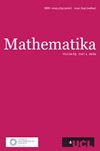Kℵ0$K^{\aleph _0}$游戏:顶点着色
IF 0.8
3区 数学
Q2 MATHEMATICS
引用次数: 0
摘要
我们研究了Maker和Breaker在一个无限完全图上玩的游戏,该图的顶点用给定集合中的颜色着色,每种颜色都无限频繁地出现。玩家交替地声明边,Maker的目的是声明一个足够丰富多彩的无限完整子图的所有边,而Breaker的目的是防止这种情况发生。我们证明,如果只有有限多个颜色,那么Maker可以获得一个完整的子图,其中所有颜色都无限频繁地出现,但如果有无限多个颜色的话,Breaker可以防止这种情况。即使有无限多个颜色,我们也证明了Maker可以获得一个完整的子图,其中无限多的颜色每个都无限频繁地出现。本文章由计算机程序翻译,如有差异,请以英文原文为准。
The
K
ℵ
0
$K^{\aleph _0}$
game: Vertex colouring
We investigate games played between Maker and Breaker on an infinite complete graph whose vertices are coloured with colours from a given set, each colour appearing infinitely often. The players alternately claim edges, Maker's aim being to claim all edges of a sufficiently colourful infinite complete subgraph and Breaker's aim being to prevent this. We show that if there are only finitely many colours, then Maker can obtain a complete subgraph in which all colours appear infinitely often, but that Breaker can prevent this if there are infinitely many colours. Even when there are infinitely many colours, we show that Maker can obtain a complete subgraph in which infinitely many of the colours each appear infinitely often.
求助全文
通过发布文献求助,成功后即可免费获取论文全文。
去求助
来源期刊

Mathematika
MATHEMATICS, APPLIED-MATHEMATICS
CiteScore
1.40
自引率
0.00%
发文量
60
审稿时长
>12 weeks
期刊介绍:
Mathematika publishes both pure and applied mathematical articles and has done so continuously since its founding by Harold Davenport in the 1950s. The traditional emphasis has been towards the purer side of mathematics but applied mathematics and articles addressing both aspects are equally welcome. The journal is published by the London Mathematical Society, on behalf of its owner University College London, and will continue to publish research papers of the highest mathematical quality.
 求助内容:
求助内容: 应助结果提醒方式:
应助结果提醒方式:


